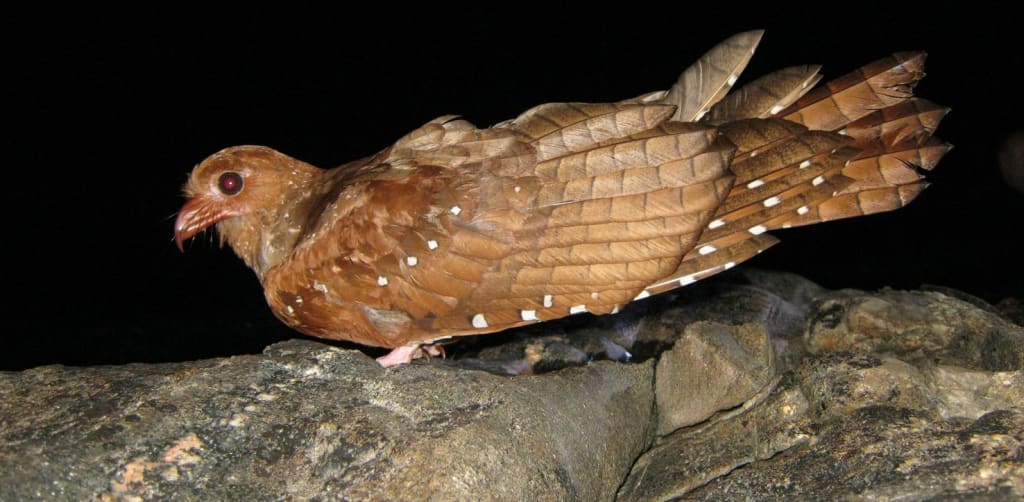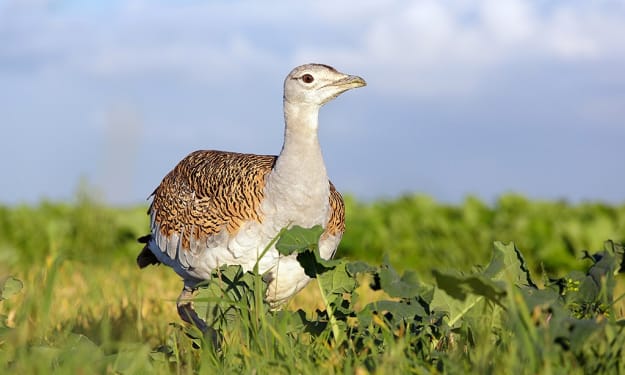Oilbird
A South American bird that behaves like a bat

The oilbird (Steatornis caripensis) is a South American bird that has adopted a lifestyle more like that of bats than the average bird species. Flocks of oilbirds spend the day on ledges high up in forest caves and sweep out at dusk to feed.
Distribution and habitat
Oilbirds are found in the forests of northern South America, notably in Venezuela, Colombia and Bolivia. They are also found on the island of Trinidad and in western Guyana.
Populations tend to be local, being dependant on the presence of suitable caves. Although individual birds may fly long distances when foraging, they always return to the same cave and are likely to spend their whole lives in the cave they were born in.
Appearance
Oilbirds are up to 18 inches long with a 3 foot wingspan. The tail is long and wide. The powerful hooked beak has whiskery feathers on each side. The legs are short.
The plumage is a rich brown in colour, with darker bars on the wings and tail. There are conspicuous white spots on the head, wing coverts, and the edges of the tail and flight feathers.
Behaviour
Oilbirds are nocturnal and spend the day in caves that are pitch dark even during daytime. They have therefore developed echolocation, by which is meant the instinctive calculation of distances to obstacles by taking account of the time that the sound of a click-like call echoes back to them. Unlike bats, oilbirds use audible calls for this purpose as opposed to supersonic ones. This method of navigation only applies inside the caves, because oilbirds have excellent night vision and a strong sense of smell which are used to locate food during the hours of darkness in the forest.
Oilbirds feed on the fruit of forest trees, picking these on the wing by wrenching them off with their beaks and swallowing them whole. They rely on a limited number of tree species, notably palms, laurels and those that produce incense. The latter are preferred for feeding to their chicks, which renders the bodies of young birds particularly “oily”, hence the name.
The preferred fruits contain a single seed that is regurgitated intact once the highly nutritious pericarp has been digested. This helps the trees to reproduce in other parts of the forest, but many seeds end up on cave floors where they germinate but soon wither for lack of light.
Breeding
Oilbirds pair up and mate for life, roosting at their nests throughout the year, whether or not they are breeding. An oilbird nest is a mound made from semi-digested fruit pulp. The nest continues to grow as new material is added but will eventually fall from its ledge and have to be rebuilt.
A clutch of up to four eggs is laid over a period of two or more weeks, with several days elapsing between the laying of each egg. Incubation begins as each egg is laid and may take up to 34 days. The chicks therefore hatch at intervals and grow very slowly, being fed entirely on fruit.
A chick at 70 days old may weigh more than a parent bird but then lose weight as the adult plumage grows. The interval from first egg-laying to the fledging of the last chick can be as much as six months.
Conservation
Early Western explorers discovered that oilbird chicks were an excellent source of oil for lamps and cooking, and this led to the species coming under severe threat.
However, the oilbird is now a protected species in much of its range, with the main threat coming from deforestation, which has grown to epic proportions in the region in recent years
About the Creator
John Welford
I am a retired librarian, having spent most of my career in academic and industrial libraries.
I write on a number of subjects and also write stories as a member of the "Hinckley Scribblers".
Enjoyed the story? Support the Creator.
Subscribe for free to receive all their stories in your feed. You could also pledge your support or give them a one-off tip, letting them know you appreciate their work.






Comments
There are no comments for this story
Be the first to respond and start the conversation.